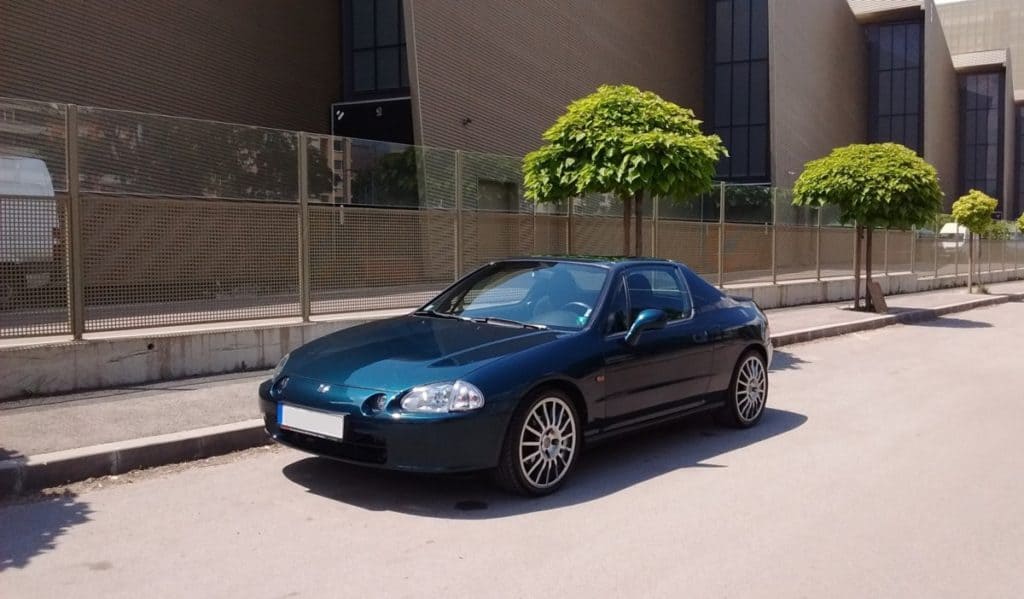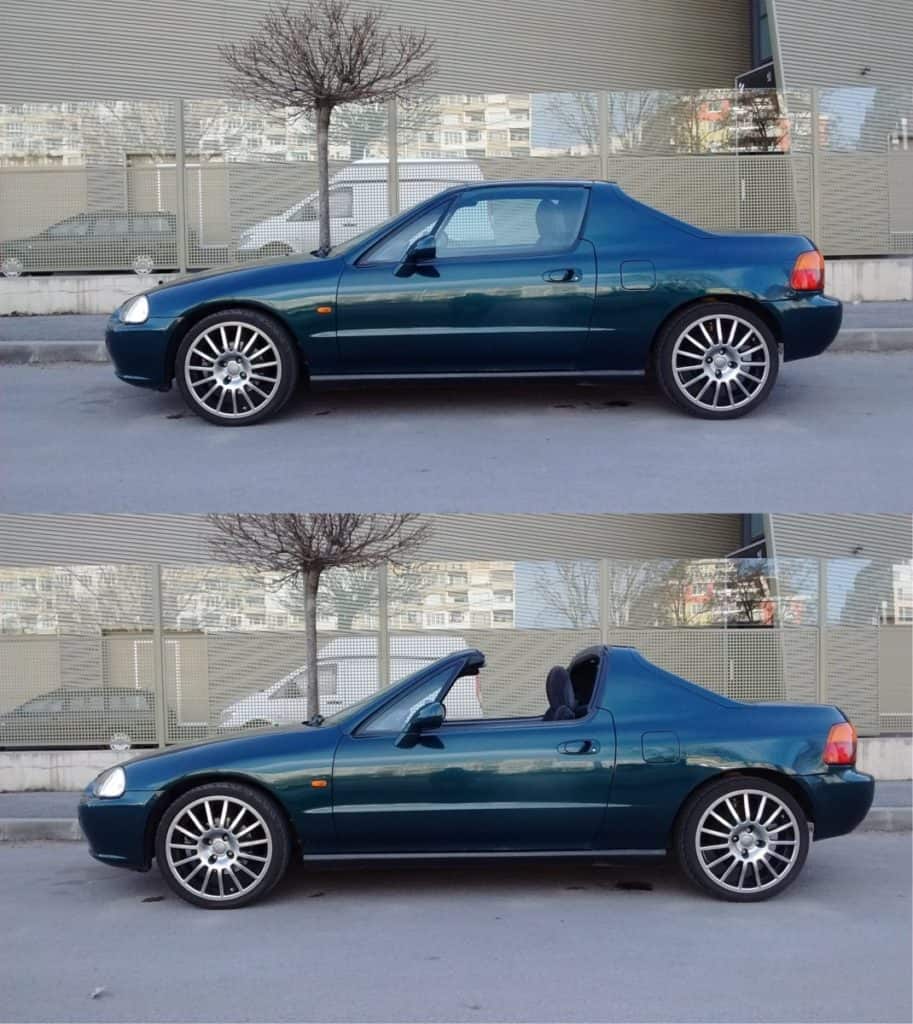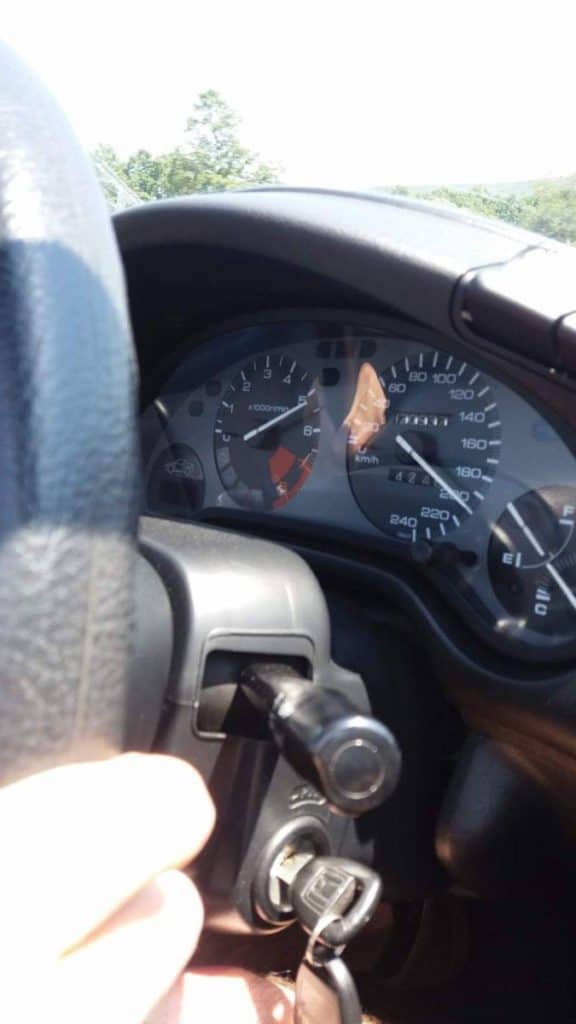Generally speaking…
A lot has been said and written about the first two generations of the Honda CRX. But I think that the last – third generation (also called Del Sol) deserves more attention too. A lot of people don’t even consider the two-door targa-top car to be a successor of the previous two generations of CRX, but in most countries, it was marketed as such.
The 3rd gen. CRX (or Del Sol) was sold between 1992 until 1998 (until 1997 in the US). Despite its form hinting being a rear-engine car, it is a front-engine, front-wheel-drive vehicle. Yes, I agree that it would have been better if it really was built as a rear-engine, rear-wheel-drive car, like the MR2 for instance, but don’t think that it is just a show car with this FF layout. Definitely, the first two generations have more pedigree in terms of driving performance. However, the third-generation was better made and still pretty lightweight (although not as much) and agile in the corners. More on that later. Now let’s examine the car in more detail.
Exterior
For some, the shape of the 3rd gen CRX is beautiful, for others – a bit odd. Maybe it is something in between. We will not discuss it as perhaps everyone who has seen this car has its own opinion on it. One is certain though – it is quite unique. It is one of those car designs where the manufacturer has been bold to make, don’t you agree? Unfortunately, as with most Japanese cars, it is plagued with rust issues, and although it is not the worst amongst the other Japanese car manufacturers, it can still be quite bad. If you are thinking of buying, check the usual places – the bottom of the doors and wheel arches.
When looking the car from the side, you can tell that it is strictly a two-seater by the lack of rear side windows. The length of the car is almost exactly four meters (157.7 in), and with a width of just under 1.7 meters (66.7 in) it is not a big car, making it perfect for city driving and parking. The driving position is low, but this is not in detriment for the ground clearance, it being 140 mm or 5.5 inches.

The targa top – well, this is one of the most distinctive features of this car, and it really adds up to the cool factor. The aluminium roof panel is light, weighing at 10.4 kg (23 lb). Due to this, it should not be a problem for most people to store it only by themselves in the dedicated slot in the trunk. This is if you have the manual option because there was also an electric one, called the “TransTop” and it is quite a show. The whole trunk lid raises flat, a carrier frame extends from the front side of it and catches the already lifted back part of the roof, retracting it under the trunk lid, and then the whole thing goes back down to cover the boot space. The entire procedure is not really fast, taking about 30 seconds. Still, it really is one of the car’s most iconic party pieces.
The wheel arches can fit 17-inch wheels with no issues and maybe 18-inch too if you want to go for extreme, but any more than that starts to become too much for the car (on the pictures above, it’s with 17s Rondell 0026). When new, the buyers could have opted for a factory boot spoiler. The car which we are reviewing didn’t have it, but a lip spoiler was installed to emphasize the profile of the CRX. That’s pretty much it in terms of the exterior of the car. Now let’s see what’s inside…
Interior
… And there is – not much really. But that is not necessarily a bad thing. The car is supposed to be lightweight and fun, not an S-class in terms of features. Speaking of features though, it has some aces up its sleeve. Apart from the electronic roof, if fitted with it, a cool and rare one for the auto industry is the retractable back window which provides the cabin with an airy feel if down when the car is in motion. You definitely would want it to work as it will be a shame if it doesn’t (it is repairable though).
The first owner of the car could have opted for an air conditioning and if you are on a lookout for a CRX, try to find one which has it. Some people will say that you don’t need it since it is a convertible but chances are that you’ll still sweat regardless if the roof is up or down, so it is better to have it. Another cool feature is the cover of the radio which hides it deployed. Other than that, you have power windows (including the back window too of course), power steering, cruise control if the car was ordered with such and that’s really it. There is also a rare option called “Motegi” which came with leather seats. A good thing is that you really get a lot of storage places in the car. There are two small lockable storage compartments behind the seats and a couple of non-lockable ones in the middle between the driver and passenger. Apart from these, if the seats are not far back, you can use the space behind them to store things too. The dials are neat, and the dash is soft to the touch. Overall the materials are better than the previous two generations of the CRX, and as a whole, the interior is well put together and laid out. You get that cockpit feel when sitting inside. This doesn’t mean that it lacks space, though. Yes, if you are a bigger person, it can be tight, but for the average male or female, it is perfectly fine. In terms of seating and the seats – as already mentioned, you sit relatively low, which emphasizes the sporty feel of the car and the seats themselves are comfortable and hugging for most people. And this is important when driving on corners.
In regards to the safety features, I’m afraid that there aren’t many. The European models got only a driver’s front airbag, while the US market also got a passenger’s one. On some CRXs, you also get ABS, but it is a very early version of this technology, and it works oddly. The car was made in an era when the safety was not yet a priority, and this can be felt.
The trunk is 300 litres if the targa top is manual which makes it a rather practical car for its size and category. If with the electric targa roof, the boot space is halved in order to accommodate all the lifting and retracting mechanisms.
Although a lot of people claim that all targas leak, this is not the case. For example, it would be fair to say that the car on the pictures rather didn’t, and it was tested on some pretty severe downpours. I used “rather” as the only times when it dripped a few drops in was when, during rainfall, the door was opened for some reason. This got wet the inside of the seal just where it meets the door’s window when the door is closed. This, to my understanding, maybe created a wet film between the window and seal. Even then, the dripping was not significant – a drop every now and then from only one place. Nevertheless, if buying – always check by pouring a few litres of water over the roof and windows as I have seen instances where the leaking can be quite terrible. It is also advisable to treat the seals every now and then.
Engines
You don’t have much choice here. If you are in a country where Honda was selling the 3rd gen CRX (or Del Sol), you would usually have had two engines to choose from (Japan got more). It can be said that the total amount of power plants were five, but they are very closely related to each other, all of them being part of the “B” and “D” families of engines Honda produced at that time.

Starting from the least powerful – the D15B7 was a single overhead cam (SOHC) 1.5 litres engine with a modest 102 hp output. It was available as the base option for the Japanese market. Then you had the D15B VTEC, which was again a SOHC 1.5 litre Japanese market option, producing 130 hp. The European and US markets both received the 1.6 litre D16Z6 VTEC which was SOHC too and produced 125 hp. The top European version was the B16A2 which was a dual overhead cam (DOHC) engine producing the 100-hp-per-litre – 1.6 l – 160 hp. And on the top of the engine tree sits the DOHC B16A engine, producing 170 hp from 1.6-litre displacement and an astonishing for the day and age redline of 8200 RPM. Unfortunately, this engine was not available in Europe or the US.
None of the motors is torquey (the most powerful one producing 157 nm or 116 lb-ft), but at least the car is light.
Driving it
So, what’s it like to drive a Honda CRX Del Sol? With two sentences – the car is not fast but is nippy in a pleasant way, it has very decent handling, and it is lightweight in a way that you can very much feel. The steering and pedals are light too, and in long-standing Honda tradition, the stick shift is phenomenal – precise, close-ratio and a pleasure to operate with.
The latter brings me to the following – please go at 100% for a CRX with a manual gearbox. Don’t buy it with the fun-spoiling 4-speed automatic as a lot of the car’s driving experience will be lost.
In terms of the driver’s positioning, you sit very low in the car. The visibility is rather good with not wide front window pillars and good rear visibility through the back window. This is subjective, but most probably you will not feel cramped in the car too unless you are a rather big person. As mentioned, you get a cockpit feel when inside, strengthened by the tall centre console between the driver and passenger. Due to the small dimensions of the CRX, at all times you sense its positioning on the road, which gives you confidence, especially when driving dynamically.
When driving the Del Sol, I could say for myself that I was able to feel the road surface well through the rather direct steering wheel, which gave me enough feedback. Due to this and the well-sorted independent, double wishbones suspension (front and rear) of the car, you kind of always know where its limit is in terms of handling. If you pay attention when driving, you can easily feel when the vehicle is about to start under-steering, for instance. And when you lift your foot off the gas pedal, it does not try to get you in even more trouble. This makes the third-gen CRX alright for relatively inexperienced drivers, although in my opinion, the first car of every person should be a safer one. The Del Sol we tested also featured factory front and rear anti-roll bars and aftermarket height adjustable KW coilovers.
The power of the car is especially subjective. Some will say that it is sufficient, others will argue that it is not. The tested CRX is with the least-powerful 1.6-litre engine, producing 125 hp at 6600 rpm and 144 Nm (or 106 lb-ft) of torque on 5200 rpm. Its acceleration 0-100 km/h (0-62 mph) is for about 9 seconds. However, due to the lightness (weighing between 1041 and 1150 kg or 2295 – 2535 lb, depending primarily on the presence of the automatic targa roof) and low seating of the car, it feels faster. I wouldn’t say that the not very quick acceleration is a real drawback, but the lack of torque is. Especially on a highway, like almost all naturally aspirated small engines, the 1.6 gets out of puff pretty quickly, compelling you to plan and be considerate of your overtaking more. In town, it is not so bad, but often I felt the need for more torque even then. Again speaking for its highway performance, the Del Sol’s cabin is not very well isolated, and this can make you wearisome on long journeys. That being said though if you like driving with the roof down on motorways, the buffeting of the wind, in my opinion, is not bad at all if the windows are up (unless the speed is above ~150 km/h or 93 mph). This is maybe due to the construction of the Del Sol which doesn’t need a wind blocker behind the seats as a conventional cabrio does.
In terms of its top speed, various sources on the internet claim that, with the engine our car was, it is between 180 km/h (112 mph) and 190 km/h (118 mph). We have tested it with the roof down with two people in it, and a 200 km/h (124 mph) was achieved at around 5300 rpm, according to the speedometer (which in most cars usually shows a bit higher than the real speed). The car felt like it was capable of going even faster, but we didn’t have enough space. Moreover, the acceleration through the last 20 km/h (~13 mph) or so was becoming a bit scary for me as the CRX’s steering wheel was starting to feel very light for my liking. The presumption that it could have gone quicker is also backed up by the official figures which state that the maximum output of this engine comes at 6600 rpm. It is not uncommon for the Japanese manufacturers to lower the expectations when providing the official top speed estimates of their cars. Even knowing the above, the achieved speed was still rather amazing especially when you take into account the fact that the CRX we have tested was stock in terms of power, without a roof and had around 210 thousand kilometres on the clock (approx. 130 thousand miles). I reckon that if we had enough closed runway and with the roof up, to enhance the aerodynamics (and if we were not scared), we could have achieved maybe 220 km/h (137 mph) or even more in the remaining until 6600 rpm range. Still, I would rather not do this test again with this little Honda.
Overall, the Del Sol is not a good GT car but this is not what it was meant for. Despite being a front-wheel-drive vehicle, it provides wonderful cornering fun. Get it on a twisty extra-urban, not very demanding in terms of inclination road and marvel at the CRX’s ability to put a smile on your face corner after corner.
Owning it
Owning the 3rd gen Honda CRX is not expensive compared to most other cars. The car is easy to work on, which means that the cost of labour of your local mechanic shouldn’t be high. The same goes for the parts prices. Some body panels can be a little bit hard to come by, depending on where you live, but they can be sourced. The car is not plagued with any significant issues, and the engines are usually quite reliable. The only thing you have to bear in mind in terms of the motors is the tendency of oil consumption. You can expect this to be quite high in some cars, so it is advisable to check its level often and to always have some oil reserve in the trunk. Make sure to check it before any long journeys. The Del Sol is generally an economical car too. You can expect an urban consumption between 8 and 11 litres per 100 km (35 to 25 British MPG) and anything from 5 l/100km (55 MPG) to a lot extra-urban depending on your style of driving of course.
Conclusion
So, is the Honda Del Sol or 3rd gen CRX any good? That would depend on what you are looking for. While it would not be fair to compare it with the MX5 or MR2 in terms of driving, as they are both rear-wheel-drive cars, there are people who prefer front-wheel drive for one reason or another and still love the driving experience. Maybe these people are the owners who would most appreciate this Honda. The bigger luggage space (if with the manually removable roof) in the trunk and the cabin can also tilt the decision of purchasing the CRX over the legendary Mazda or Toyota.
The Del Sol also came in the 90s which is generally considered the golden era of the Japanese performance cars, and although it does not boast with stellar speed and tire-shredding torque like some of its contemporaries, nor it has some fancy newer age front-wheel-drive features like torque vectoring, it remains a small fun to drive two-seater.
As always, I hope you have found this article useful and stay tuned for more. Thanks!







